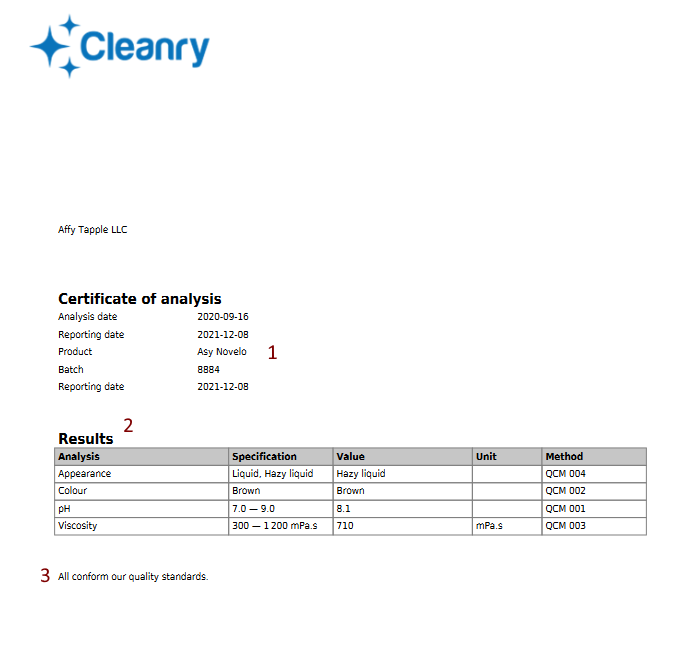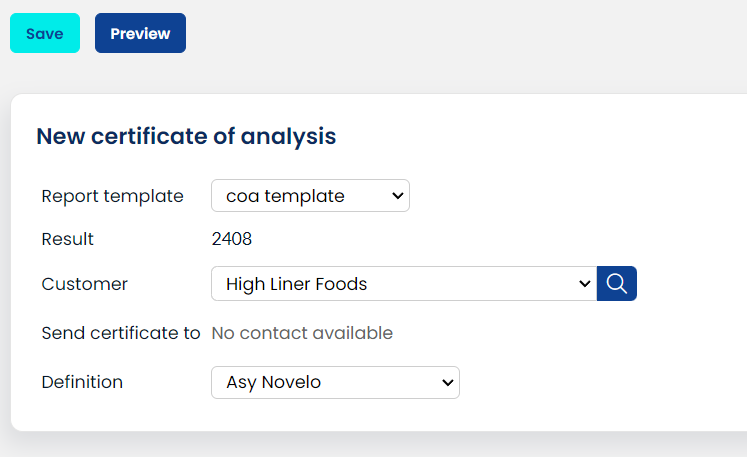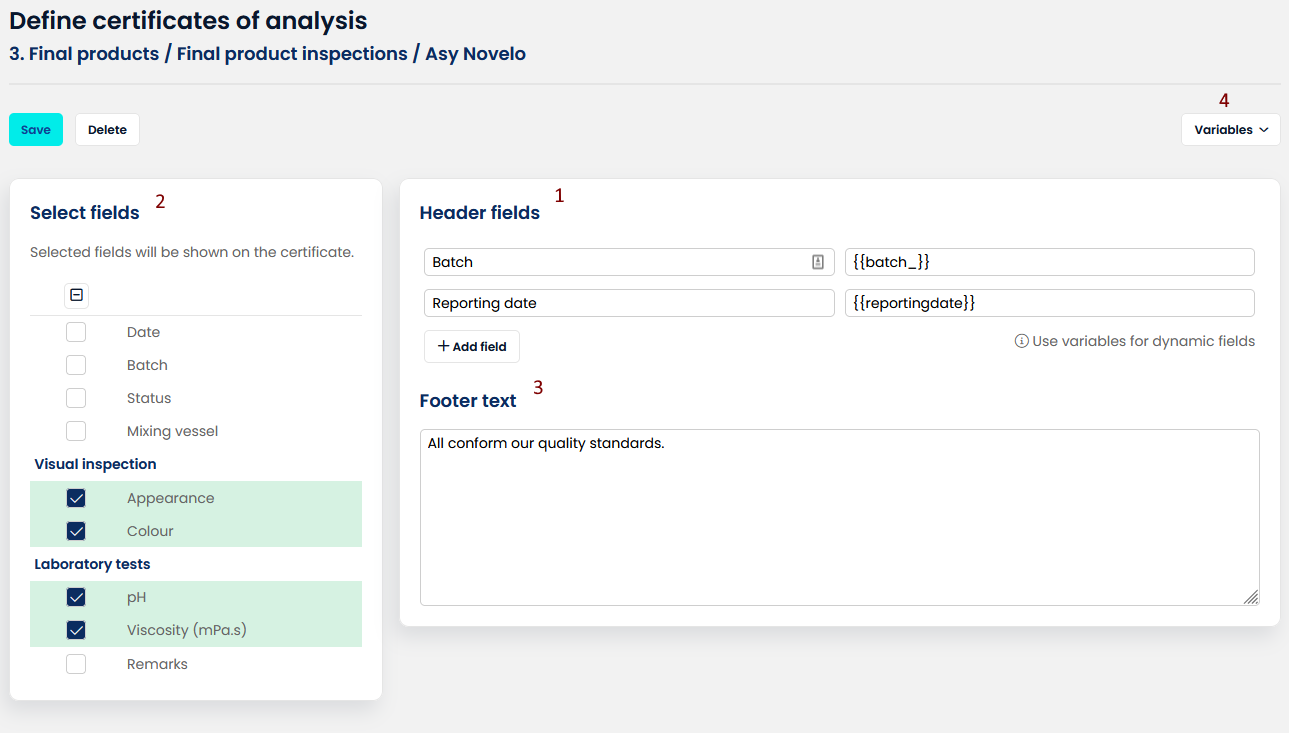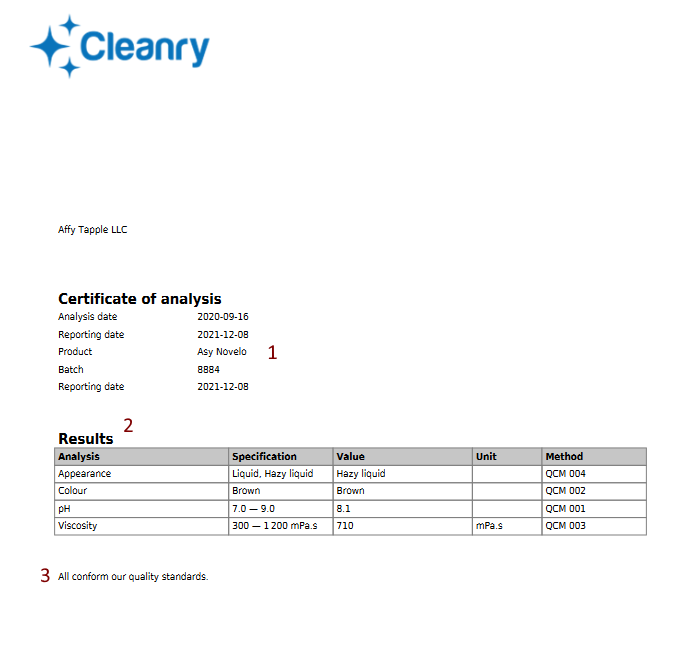Certificate of Analysis
Certificates of Analysis are used to report the quality of your products to your customers. We see an increasing demand for COAs across the industry. To help our customers deal with this increased demand, we developed a feature to automatically create, store and send COAs.
As with everything, standardization is the key to keeping processes manageable. Our COA features are built on the assumption of standardized COAs per product or product + customer combination. In AlisQI you define COA templates, and individual test results can be reported by means of these templates.
This article guides you through creating, storing, and sending Certificates of Analysis in AlisQI.
This feature is available with an active subscription to the Internal and External reporting solver within the Quality Control.
In this article
Introduction
Let's start this article with a short demo of how COAs work in AlisQI.
Appearance
You have full control over the appearance of your COAs. There is a default appearance that you can use without any configuration. However, if you want to tailor the appearance of the COA you can create Word templates that form the basis of your COA documents.
This section briefly discusses how to control the appearance of your certificates.
Default appearance
There is a default appearance where we generate a PDF document with your logo, a customizable header (1), the results presented in tabular form (2) and a customizable footer text (3). See the impression below.

If this suits your needs, you can simply define the parameters to be included in your COA definition and you're good to go. If it does not suffice, we offer custom reporting templates to tailor the look and feel of your COAs.
To change or update the logo on your default COA please contact support@alisqi.com
Word templates
If you want to have more control over the appearance and contents of your COA, you can use custom report templates and use them as the basis for your certificates. Read all about the custom report templates here, there is a section of certificate of analysis variables that allow you to use all settings from the COA definition in your custom COA templates.
Once a Custom report template is uploaded, they appear in the screen where you generate your COAs. Simply select them from the list to generate a COA from it. These reports can be stored and sent over email just as you would with any other COA in AlisQI.

The report templates require you to create a COA definition first.
COA definition
A COA in AlisQI starts with a COA definition. These definitions define which information should appear on the COA. This can consist of the three elements:
- Descriptive information, like Product name, Batch number, or Expiry date
- The measurements values to include on the report
- A (static) footer text
COA definitions can be reused for multiple products or customers, in order to standardize as much as possible. However, defining multiple templates allows you to conform to specific reporting demands your customers might have.
Variations per product
To be able to create templates per product, make sure your analysis set has a product field that is set as the index field.
Variations per customer
To be able to create templates per customer, make sure your analysis set has a selection list based on the built-in customer list.
When your analysis set has both a Product and a Customer field, you can create templates per product+customer combination.
Creating a definition
Start by navigating to the results overview of the set you would like to create COAs from. Click on Toolbar » More » Define certificates to navigate to the template management section. Depending on the setup of your analysis set, you can select a product or customer to define the scope your templates apply to.
Technically, you can make COAs from every analysis set. However, typically we see customers create COAs from their final product data.
In the template management screen, you define the COA template.

This screen has three sections:
- Header fields
The Header fields appear at the top of the certificate. This contains descriptive information like product name or batch number. Use variable placeholders (4) to refer to dynamic result values.
By default, the analysis date, print date, product (if set as index field), and the customer are added in the header section. - Analysis results
In the section Select fields (2), you add the fields that you want to include on the certificate. These result values are presented in tabular form, with their specification limits, unit, and test method. - Static footer text
This section enables you to define the static text that needs to appear on the certificate. If necessary, you can also use variables here to include result values in the footer.
Having defined your template, you can use it to generate and send out a Certificate of Analysis.
Generate Certificate of Analysis
After selecting a customer, you can select which contact persons at that customer will receive the COA as a PDF email attachment.

Once stored, the Certificate of Analysis is linked to the result as a PDF file for archiving purposes.
If needed, AlisQI can be configured to prevent generating COAs with off-spec values. Contact AlisQI support for more info.
Example Certificate of Analysis
The screenshot below depicts a COA generated from AlisQI as defined by the template depicted above.
We marked the building blocks: The header (1), the measurement values (2), and static footer text (3).

As mentioned before, the company logo is part of the template and can be adjusted to your corporate branding.
Customers and contacts
If you want to send our COAs to customers directly from AlisQI, you need to upload your customers and contacts.
To do so, got to Menu » Management » Certificate of Analysis » Customers or Contact persons
Incoming supplier certificates
Your suppliers probably provide you with certificates as well. These certificates can be uploaded to your raw material intake records as attachments. This way you have all information regarding incoming quality in one central location.
When you upload certificates as native PDF, all contents are indexed and can be found via the internal search engine. This allows for quick lookup by purchase number of raw material code.